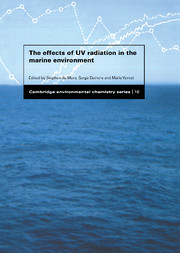Book contents
- Frontmatter
- Contents
- Contributors
- Preface
- 1 Enhanced UV radiation – a new problem for the marine environment
- 2 UV physics and optics
- 3 Spectral weighting functions for quantifying effects of UV radiation in marine ecosystems
- 4 Marine photochemistry and its impact on carbon cycling
- 5 Photochemical production of biological substrates
- 6 Mechanisms of UV damage to aquatic organisms
- 7 Strategies for the minimisation of UV-induced damage
- 8 UV radiation effects on heterotrophic bacterioplankton and viruses in marine ecosystems
- 9 Effects of UV radiation on the physiology and ecology of marine phytoplankton
- 10 Impact of solar UV radiation on zooplankton and fish
- 11 Implications of UV radiation for the food web structure and consequences on the carbon flow
- Index
11 - Implications of UV radiation for the food web structure and consequences on the carbon flow
Published online by Cambridge University Press: 20 August 2009
- Frontmatter
- Contents
- Contributors
- Preface
- 1 Enhanced UV radiation – a new problem for the marine environment
- 2 UV physics and optics
- 3 Spectral weighting functions for quantifying effects of UV radiation in marine ecosystems
- 4 Marine photochemistry and its impact on carbon cycling
- 5 Photochemical production of biological substrates
- 6 Mechanisms of UV damage to aquatic organisms
- 7 Strategies for the minimisation of UV-induced damage
- 8 UV radiation effects on heterotrophic bacterioplankton and viruses in marine ecosystems
- 9 Effects of UV radiation on the physiology and ecology of marine phytoplankton
- 10 Impact of solar UV radiation on zooplankton and fish
- 11 Implications of UV radiation for the food web structure and consequences on the carbon flow
- Index
Summary
Introduction
Given the anticipated decreasing concentrations of stratospheric ozone, the concern regarding the effects of UV radiation (UVR) in the environment is very topical. The preceding chapters in this book provide a state-of-the-art review of UVR effects in the marine environment (see Figure 11.1). This last chapter synthesises briefly the potential UV-induced responses at community and ecosystem levels and gives an insight on how the global changes can interact with the direct impacts of UVR.
The increase of anthropogenic chlorofluorocarbons (CFCs) is responsible for the destruction of ozone in the upper atmosphere. This decrease in the ozone layer causes in an increase of UV-B radiation in the wavelength range 280 to 320 nm (Chapter 1). The past decade has been witness to a concentrated effort from the international scientific community tomeasure the increase of UVR and to understand its effects on different ecosystems. These efforts were supported by signatories to international agreements, such as the Montreal Protocol, to control and eliminate the production and emission of ozone-depleting substances. However, each spring, an ‘ozone hole’ larger than the size of Canada appears over the Antarctic region (Smith et al., 1992). In the Arctic and into the north temperate zone, the ozone layer diminished by more than 45% during the 1997/8 winter, the most important decrease in 35 years (Wardle et al., 1997). Notable ozone depletion has now been observed in both polar regions, as ozone loss rates in the Arctic region in recent years have reached values comparable to those recorded over the Antarctic (Rex et al., 1997, and references therein).
- Type
- Chapter
- Information
- The Effects of UV Radiation in the Marine Environment , pp. 310 - 320Publisher: Cambridge University PressPrint publication year: 2000
- 9
- Cited by



